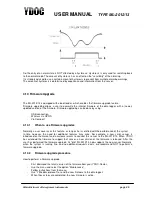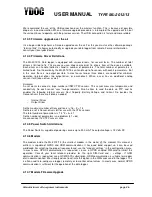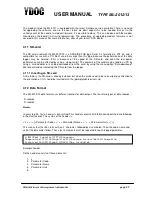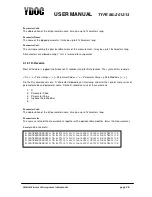
USER MANUAL
TYPE ML-2012/13
Manufacturers of low power instruments
page 37
5.3.9
Antenna placement and field strength
An antenna is required for GPRS and GSM operation. Normally you will require a dual-band antenna
suitable for 900 MHz and 1800 MHz.
Note
: that the ML-2012/13-II can also operate with 900 MHz only, where 1800 MHz is not available. In
this case a 900MHz antenna will fulfill.
Depending on local field strength a simple whip antenna direct connected to the ML-2012/13 will work, or
a better antenna and/or better antenna placement might be required.
You can monitor the actual field strength through the configuration software(menu). The field strength
may vary on atmospheric conditions, so we recommend you to make sure that the indication is
maximized at installation
The field strength may also vary on the growth of vegetation (trees tend to block the signal). We also
recommend configuring the ML-2012/13 in such a way that the GPRS field strength is recorded. In this
way you can get an early warning when the field strength gets low.
What to do to get a better field strength signal;
•
Make sure the antenna is mounted in accordance with the manufacturer’s instructions. Note there are
antennas (whip antennas) that require a metal surface below the antenna; others (dipole antennas)
do not.
•
Make sure that all connectors on the antenna and antenna cable are tightened and free of moisture.
•
Make sure the antenna is in vertical position; as the GSM and GPRS radio signals are vertically
polarize, the antenna should be vertical positioned for maximum performance.
•
Do not place the antenna near metal surfaces or structures. Be aware that various building structures
contain metal (e.g. steel mesh as reinforcement for concrete).
•
Place the antenna outdoors.
•
Identify the nearest GSM tower of your provider. Place the antenna in a location that provides a free
line-of-sight to the tower.
•
If you cannot identify the nearest GSM tower of your provider, place the antenna on a higher position;
generally, higher is better.
•
Use good quality (low-loss) antenna cables. Generally, the thicker the cable, the better.
•
Avoid unnecessary adaptors and connectors in the antenna cable, as every “joint” cause a significant
signal loss (0.5 to 1 dB).
•
Use an antenna with a higher antenna gain. (simple stubby antennas can have a gain of -9db, a rod
antenna can have an antenna gain of 0 or 4 dB or higher; Note that the allowed radio power is
limited to 1W/2W. An antenna with a higher gain is only allowed when this only compensates for the
cable and connector losses).
•
Seal your antenna-connector with vulcanizing tape, to prevent from oxidation
Make sure the SIM you intend to use is compatible with your network and the pin code protection is
disabled.
6
Maintenance and Repair
6.1 RTC Lithium Battery replacement
The battery of the ML-2012/13 Data logger is designed to last for the lifetime of the instrument. It should
not be necessary to replace this battery. If it has to b replaced anyhow, it has to be done by an YDOC-
certified dealer.









































